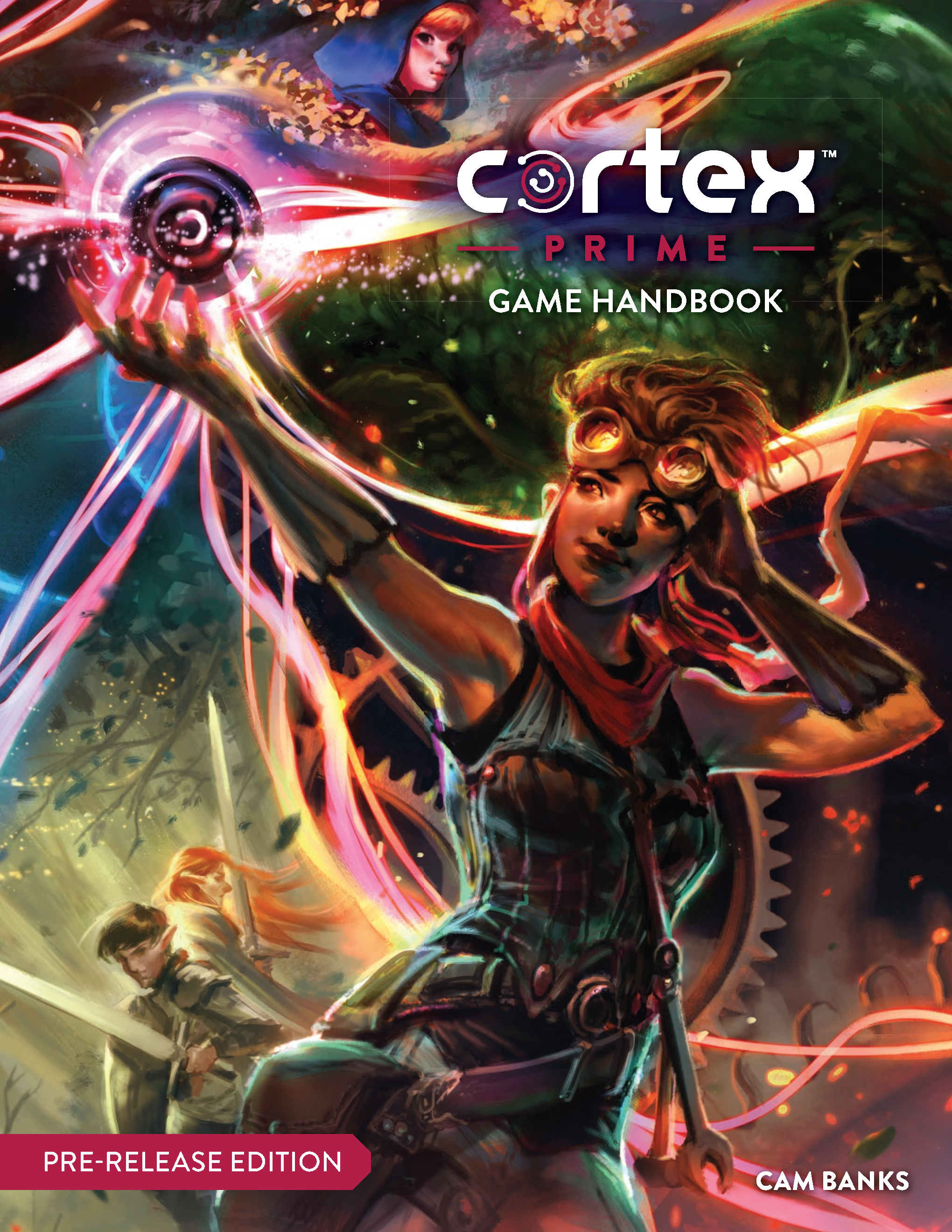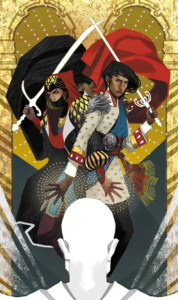
TM & © 2020 Fandom
This article is the first of what I hope will be many RPG overviews that I’m calling my “The Skinny” series. The goal isn’t to give an exhaustive list of every rule or element in a game, but rather to give a basic impression and understanding of it. This will generally include the core mechanics, character creation options, the sort of gaming experience the game aims to create, and any other salient points that I think GMs and players should know.
Cortex Prime is a generic roleplaying game developed by Cam Banks, based on previous iterations of the Cortex system used in such games as Leverage, Smallville, Marvel Heroic Roleplaying, and the Firefly RPG. The project had a successful Kickstarter campaign, and despite a number of major setbacks during development that delayed the game’s completion by nearly 2 years, the game is finally ready to launch. As one of the Kickstarter backers, I recently received my pre-release PDF and I’m excited to dive into it and share my first impressions.
What is Cortex Prime?
I’m going to start off with the question that anyone reading this article surely wants to know above all else: What is Cortex Prime? The short answer, straight from the book, is that Cortex Prime is a “multi-genre, modular, session-centered roleplaying game.” The game bills itself as being able to handle most genres, but also suggests that cinematic, dramatic settings will work best; games that go beyond mere hacking and slashing and that place emphasis on the relationships, personalities, and competencies of the PCs should be particularly well-suited to this ruleset. This is welcome news to me, because those elements are essential to the games I run anyway.
Speaking to the modularity of the system, the game offers a wide variety of alternative and optional rules for various core mechanics. Many of these modular rules appear to be formulated from or inspired by previous games that used the Cortex and Cortex Plus systems, such as incorporating the Doom Pool mechanics from Marvel Heroic Roleplaying; there are also optional rules that aim to recreate more traditional game mechanics like Life Points (basically an HP system) or having set difficulty numbers rather than having the Game Moderator (GM) roll a difficulty pool for each check. This was a fantastic choice, in my opinion, because it creates a space for both long-time Cortex fans and those gamers who are used to the conceits of the d20 system and similar rulesets.
The final descriptor, “session-centered,” appears to emphasize the cinematic experience the game aims for in each individual session. The game assumes a cinematic structure for session design, and introduces the reader to screenwriting terminology concepts like “beats,” and “screen framing;” the mechanics reinforce this structure with things like flashbacks and creating assets during bridge scenes. All in all, this game looks like an excellent choice if cinematic gaming is one of your primary goals, as is the case for me.
Noob-Friendly
If you’ve never played or perhaps have never even heard of the Cortex System before, you’ll be happy to know that this book does a bang-up job introducing the rules and concepts in noob-friendly ways. For example, the game introduces concepts and keywords using a bold font along with a simple and concise definition. There are multiple examples of the core mechanics that are paired with illustrations so you can watch the described scenario come to life. Additionally, visual aids and symbols help to process and organize the various elements of the game in your mind as you learn them. I’m truly impressed with how well-organized and presented this game is; it’s clear that a lot of thought and effort went into making the game as digestible as possible. As someone who is passionate about bringing new players in the hobby, I’m always looking for systems that are easy to learn and teach; Cortex Prime certainly seems to a prime example of this type of game (pun absolutely intended).

TM & © 2020 Fandom
Core Game Mechanics
I know, I know – stop yammering and get to the good stuff. Your wish is my command. The book provides a Primer at the very beginning that covers the most basic essence of the Cortex Prime system that can be summarized as follows:
-
Create a Trait for your character
-
When a PC wants to do something, roll three dice if their Trait could help them accomplish their goal, or two dice if the Trait wouldn’t help them
-
The GM decides a difficulty rating from Easy (one die) to Hard (three or more dice)
-
The player and GM both look at their two highest results and add them together – if the player’s total equals or exceeds the GM’s total then the PC succeeds, otherwise the PC fails
Let me go into a bit more detail on these points. First off, Traits. A Trait in this particular context is a phrase that describes the core concept of your character. This could be anything from “Grizzled Beat Cop” to “Vicious T-Rex” (What, do you not have dinosaur PCs in your games?). You may also be wondering why I didn’t specify what type of dice are rolled in the steps above. The reason for this is because while the example from the Primer seems to use d6s as the default, in practice Traits have ratings that can range from a d4 to a d12. There are also multiple types of Traits that a Cortex Prime game can incorporate based on the setting and playstyle, including Attributes, Skills, Affiliations, Relationships, Powers, Roles, and Values; any given dice pool could contain multiple dice types based on various combinations of a PC’s Traits. You’ll also notice that I mentioned that the GM rolls dice based on the difficulty of an action. As I mentioned above, by default a PC always rolls against the GM’s difficulty pool. This is one of the more unique aspects of the Cortex Prime system; I don’t see many games that has the GM roll when there isn’t active opposition from an opponent. It does seem a little weird, but it’s also necessary if you want to utilize all the default core mechanics of the game, as you’ll see shortly.
Another core mechanic in any Cortex Prime game is the Plot Point. A Plot Point is a type of meta-currency that the players can use to affect the narrative beyond rolling dice. Gamers familiar with systems like Genesys or Fate likely will be familiar with this sort of mechanic. Using one of their Plot Points can provide the player with benefits such as adding more dice into their pool, “stepping up” the value of one or more dice in their pool (i.e d6 → d8), activating certain special effects (SFX) the PCs may have, or introducing new elements to the current narrative. By default, a Cortex Prime PC starts each session with at least one Plot Point.
Two more important core mechanics to mention are Assets and Complications. Assets and Complications are each a sort of temporary Trait that helps or hinders a character, respectively. Assets can be created with Plot Points during play, take a d6 value by default, and can be added to its creator’s dice pool when it would help them perform an action. Assets can include things like “Crowbar,” which a character could use during a fight scene, “Fancy Clothes,” which could help a character impersonate an important official, or even something like “Extra-Vigilant,” which might help a character notice if a treasure chest has been trapped. A Complication, on the other hand, is created when a PC rolls a Natural 1 (a “Hitch” in Cortex Prime parlance). When this happens, the GM can give the player a Plot Point to create a Complication for the PC. The GM describes the Complication (ex. “Moderate Winds”) and sets its value to d6 by default; they may add the Complication’s die type to their dice pool whenever it might be relevant to the narrative (ex. a “Moderate Winds” Complication could be added to the GM’s difficulty pool if the PC tries to hit a golf ball). If additional Hitches are rolled during the scene, the GM has the choice to either create a completely new Complication, or to increase the die type of an existing Complication (i.e. a d6 Complication “Moderate Winds” Complication could become a d8 “Strong Winds” Complication). A PC can only have one Complication of each die type, so any Complication that would otherwise violate this rule is automatically stepped up to the next-highest die type. If a Complication is stepped up beyond a d12, the PC is overwhelmed and can no longer take actions during that scene without spending a Plot Point; in that circumstance, however, only one die from the pool may be kept for the total.
The GM can also roll Hitches in their pool, but rather than receiving a Complication, the PC instead is given an opportunity; the PC can spend a Plot Point in order to “step down” the value of an existing complication by one tier (i.e. a d8 “Strong Winds” Complication could be stepped back down to a d6 “Moderate Winds” Complication). Multiple Opportunities on the same roll can be used to reduce multiple Complications one step or one Complication multiple steps. When a Complication is stepped down to a d4, rather than adding it to the GM’s pool the next time it’s relevant, the player instead adds it to their own pool; as long as the d4 doesn’t roll a Hitch, the Complication disappears. Otherwise, the GM has the option of giving the Player a Plot Point and stepping the Complication back up to a d6.

TM & © 2020 Fandom
Character Creation
Character Creation rules in Cortex Prime are, like other elements of the game, modular in nature. The book presents multiple Trait types to allow the GM to customize the character creation process to suit the game they wish to run. The book also allows provides a helpful list of “Prime Sets” that give suggestions for different combinations of Traits. Each Prime Set always includes Distinctions, which consist of three important descriptive statements about your character, and a combination of two other Trait types depending on the genre. Some example combinations include Attributes + Skills for Grim Fantasy, Values + Relationships for Prime Time Drama, Relationships + Skills for Romantic Fantasy, and Affiliations + Powers for Superheroes. I found it intriguing to see so many niche genres listed among the examples. This seems to lend credence to Cortex Prime’s claim that it can work for almost any genre. Mixing and matching Traits aside, there are three main types of character creation procedures: Archetypes, Scratch-Built, and Pathways.
Archetype character creation involves choosing from a selection of various pre-set character archetypes that contain Distinctions and other Traits appropriate to them. An example from the book is “The Engineer” archetype, which consists of Three Distinctions (“The World is My Worshop,” “Boundless Curiosity,” and “Can’t Stay Long, Too Much to Do”), each with its own list of SFX (ex. “Kitbash,” “Killed the Cat,” and “Full Speed Ahead,” respectively) and two Highlight Skills (Fix, Operate, Know, Notice, Drive, and Move). You can then customize your PC further by upgrading more of your Skills and adding Specialties and a Signature Asset from a list of choices. This character creation type works well if you want your game to have something close character classes.
Scratch-Built character creation, as you might have guessed, involves building a character basically from the ground up, effectively creating their own character archetype. By default, this includes adjusting your base Attributes; choosing Distinctions and their SFX; stepping up Skills; and choosing your Specialties and Signature Assets. However, the book also provides guidance for building characters and Archetypes using all of the other different types of Traits as well.
The final type of character creation outlined in Cortex Prime is Pathways. This method involves a collaborative and interactive approach to both the game’s setting and character creation creation process Using Pathways, players take round-robin turns introducing elements to the game setting and adding and stepping up Traits to their characters through various stages of development. Gamers who have played games like Traveller will find the process similar to a Lifepath system, except the players have more freedom to determine what sorts of life events they experience and which Traits result from them. The Pathways system is easily the most complex of the three main character creation methods discussed in the book. However, the book does a brilliant job of walking the players through each step of the process, and provides advice for how to create an effective Pathways system for the type of game you want to play.

TM & © 2020 Fandom
The Skinny
One of the difficulties in writing an overview for a game is deciding what needs to be included and what can be left out. I could have written paragraphs about how beautiful and thematic the art is (hopefully the sample art I’ve shared has given you a feel for it) or discussed all the different rule options and modifications the game provides. There’s just too much information in the hundreds of pages a given game contains to be able to touch on everything. I can only hope that the information I did provide is enough to give you a good sense of the product, how the game is played, and the sort of gaming experience you can expect from it.
In my opinion, Cortex Prime is well-designed, well-organized, and has a very flexible modular ruleset that will allow you to tweak your game to your specifications. Its design favors a more rules-light, cinematic style of play. If you’re the sort of gamer that likes to play the sorts of stories you might watch on TV or in film, then I can definitely recommend you check out Cortex Prime without reserve. On the other hand, if you prefer a crunchier, more tactical sort of gaming experience, like measuring movement across a grid or keeping track of how many arrows a character has shot, you’ll likely come away dissatisfied; not that you couldn’t try to use it for that sort of campaign, but you’d have to do a lot more work to add on the bits and pieces you want that the system doesn’t provide by default, and you’ll probably be inclined to ignore a lot of the unique elements that the system otherwise brings to the table. I, for one, am excited to get this game on my table and see what sort of exciting stories my friends and I can tell together.
Big thanks to Cam Banks for giving me the go-ahead on this article and sharing the artwork!
Do you have thoughts or questions about the article, or suggestions for future content? Leave a comment below or drop me a line at jtdimino@d20radio.com
